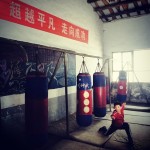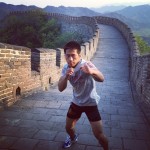I participated in my first BJJ tournament yesterday. Master’s Heavyweight White Belt (195-208lbs with Gi) and I lost 6-3 in my first match. Here’s what I remember:
We square off and he snatches my right lapel with his left arm and just holds it as hard as he can. He is not trying to do anything yet. In his face I see determination. I struggle a bit and try and dislodge him, but then I stop for a second and look at him just holding on straight-legged, and I almost laugh. I throw is arm over my head, loop out to the right, and instead of hot-kneeing around his back for a body lock, I just push his left arm in and get a chest to chest body lock. I then pick him up and throw him, fully expecting to land on him and smash away.
But somehow he landed on me.
There was a snap crackle and pop in my back and I cried out in shock. Ref stops it. EMS comes over and feels my ribs. I start tripping because my family has waited five hours to watch me get slammed and carted away on a stretcher inside of 30 seconds. I say, “I’m good let’s go!” they say cool and it’s on. He’s in mount, because that’s where he landed after my ill-executed hip throw.
I sweep him. Now I’m in his guard. I’m confused but I know now that I’m at least his equal. I go for a collar choke in his guard, which amounts to nothing. I pass his guard somehow, I think via knee slice. Somehow that becomes me in half guard and him trying to kimura my right arm from beneath me. I can feel that the kimura will not work, despite his grunting, but I am not sure what to do.
My coach yells from the sideline, piercing through the cacophony:
“Sascha, free your arm! Pull your knee out! Mount him!”
I free my arm. Pull my knee out. I get mount. And I’m promptly swept back and now he’s in my guard.
There are 20 seconds left and I get his right arm to cross center line, I am thinking maybe arm bar maybe sweep gotta get my hips up what do I do I can still win this … TIME.
Afterwards I want to go again. Immediately. I am ready to take on anyone and now, after hours of sitting there and waiting my turn and worrying whether or not I will tap to pressure or gas out or be a bitch in front of my people, Now, now I am ready, warjuice is flowing through me from top to bottom, but all I can do is step aside and let the rest of the men and women roll while I watch and begin the process of beating me up for getting beat up.
Had I held that mount for a second longer. Had I slipped to the back instead of throwing him from the chest. Had I swept from guard at the last second. Had I taken his weak kimura and re-kimura-ed it myself …
Those questions and many more in my head all night as the pain in my back moves around my body, to the armpit, and then to the chest, and then back again. When I bend down I groan. My face is burned from mat and cloth. I’m so ready for war and there is no one to fight. Everyone is kind and encouraging. Everyone says I fought well, despite having so little practice and this being my first time.
But they’re not in my head at 5am seething and reconciling, dreaming. And then seething again. Back to reconciliation with the truth and then plans for the future. Burned away in a heartbeat by the vision of a sweep unswept. These beats in my head wonder what happened to the beast when the moment came.
****
I was ready to quit BJJ sitting there waiting for my turn to come. The training is so hard on my body and I have to psyche myself up for Monday evenings facing the monsters at my gym, their kind words are stones after the second, third, and fourth time I tap to an impossible situation. It’s hard to tap me, I know that, but that means I push myself to the limits of my body and maybe that’s not really whats up. There is so much I can learn now.
People told me matches are a blur. I know what that means now. I don’t know exactly how it will play out next time – and there will be a next time – but I am pretty sure I am more ready than I was 24 hours ago. If I faced the same man today, I would destroy him. But who knows what he learned. I’m curious to find out.
All of these arts are reforging me. Piece by piece.
My two boys – 5 & 6 – competed as well. The older boy won his first match and lost a very close match the second time. He won a silver. The little one lost a close match as well. The difference is their mental and spiritual state. I am introducing them to the rivers and the lakes at an age when it can sink into their bones and become an integral part of their identity. Their reaction to winning and losing and training and competing is within the parameters of the Way. Even if it doesn’t seem so apparent all the time, each experience is another layer of paint on the portrait of who they are. I don’t need to inspect the brushstrokes to see the beauty of all those layers, but I like to.
And then I can stand back and see the picture for what it is, like a 19th century impressionist rendering of a Venetian river scene, tiny squares up close, each applied meticulously, but one blended memory from afar, transportative, transformative, real.






